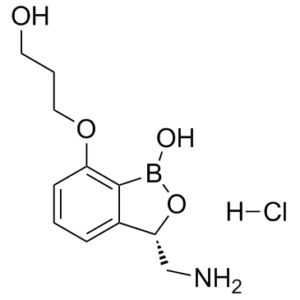This product is for research use only, not for human use. We do not sell to patients.

| Size | Price | Stock |
|---|---|---|
| 250mg | $1080 | To Be Confirmed |
| 500mg | $1550 | To Be Confirmed |
| 1g | $2325 | To Be Confirmed |
Cat #: V3637 CAS #: 1234563-16-6 Purity ≥ 98%
Description: Epetraborole hydrochloride (also known as GSK2251052 hydrochloride and AN3365 hydrochloride) is a novel, potent and selective leucyl-tRNA synthetase (LeuRS) inhibitor, which inhibits protein synthesis by binding to the terminal adenosine ribose (A76) of leucyl-tRNA synthetase. Epetraborole was under investigation for the treatment of infections caused by multidrug-resistant Gram-negative pathogens. GSK2251052 is a novel boron-containing antibiotic that inhibits bacterial leucyl tRNA synthetase. All Clostridium perfringens strains had GSK2251052 MICs of >32 μg/ml.
Publications Citing InvivoChem Products
Product Promise

- Physicochemical and Storage Information
- Protocol
- Related Biological Data
- Stock Solution Preparation
- Quality Control Documentation
| Molecular Weight (MW) | 273.52 |
|---|---|
| Molecular Formula | C11H17BClNO4 |
| CAS No. | 1234563-16-6 |
| Storage | -20℃ for 3 years in powder formr |
| -80℃ for 2 years in solvent | |
| SMILES Code | OB1O[C@H](CN)C2=CC=CC(OCCCO)=C21.[H]Cl |
| Synonyms | GSK-2251052; GSK 2251052; GSK2251052; AN3365; AN 3365; AN-3365; GSK-052; GSK 052; GSK052; Epetraborole |
| Protocol | In Vitro | Epetraborole (0-32 μg/mL) shows anti-bacterial activity against key gram-negative aerobic and anaerobic pathogens and gram-positive anaerobes |
|---|
| Solvent volume to be added | Mass (the weight of a compound) | |||
|---|---|---|---|---|
| Mother liquor concentration | 1mg | 5mg | 10mg | 20mg |
| 1mM | 3.6560 mL | 18.2802 mL | 36.5604 mL | 73.1208 mL |
| 5mM | 0.7312 mL | 3.6560 mL | 7.3121 mL | 14.6242 mL |
| 10mM | 0.3656 mL | 1.8280 mL | 3.6560 mL | 7.3121 mL |
| 20mM | 0.1828 mL | 0.9140 mL | 1.8280 mL | 3.6560 mL |
This equation is commonly abbreviated as: C1 V1 = C2 V2
- (1) Please be sure that the solution is clear before the addition of next solvent. Dissolution methods like vortex, ultrasound or warming and heat may be used to aid dissolving.
- (2) Be sure to add the solvent(s) in order.




































